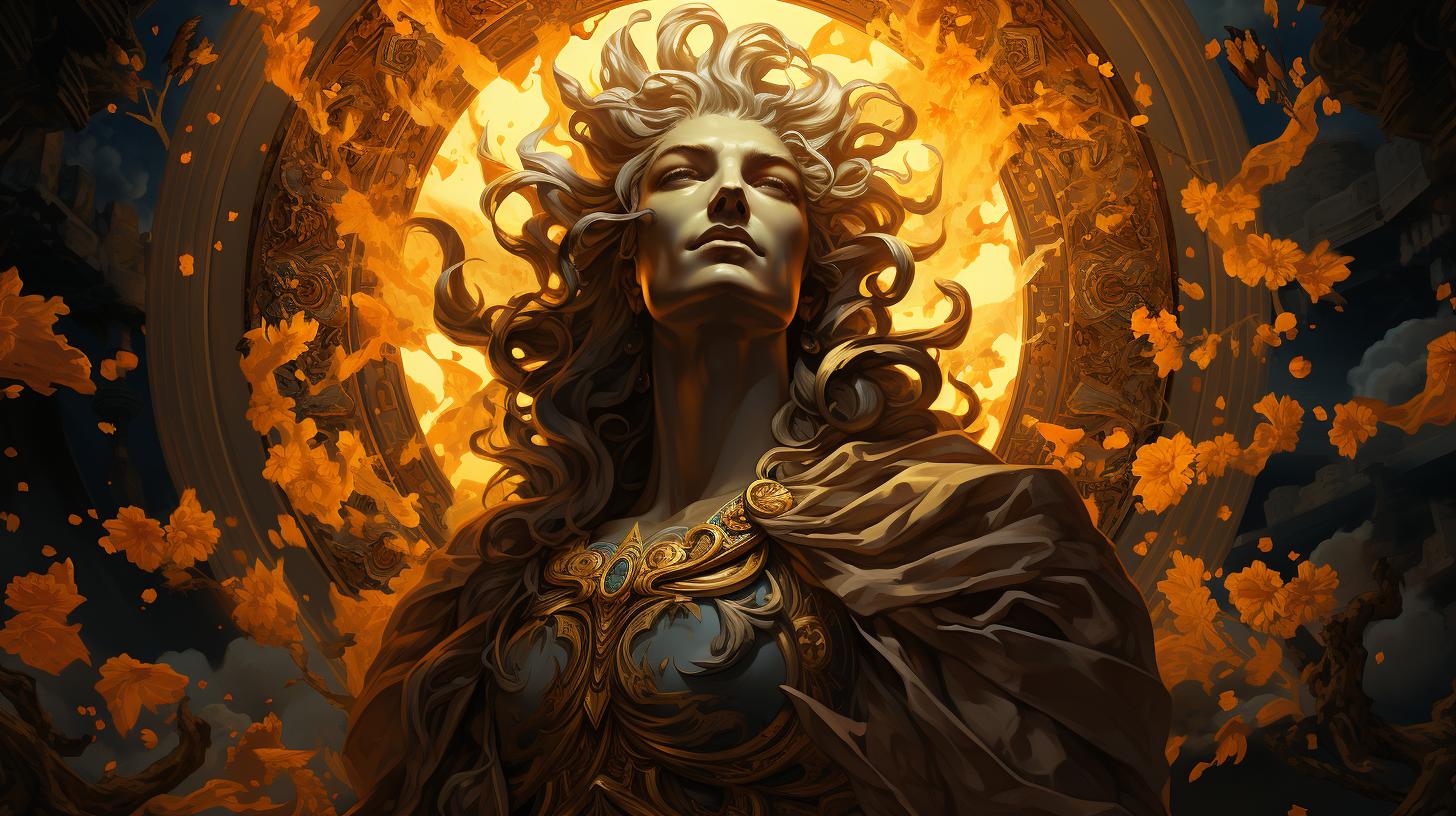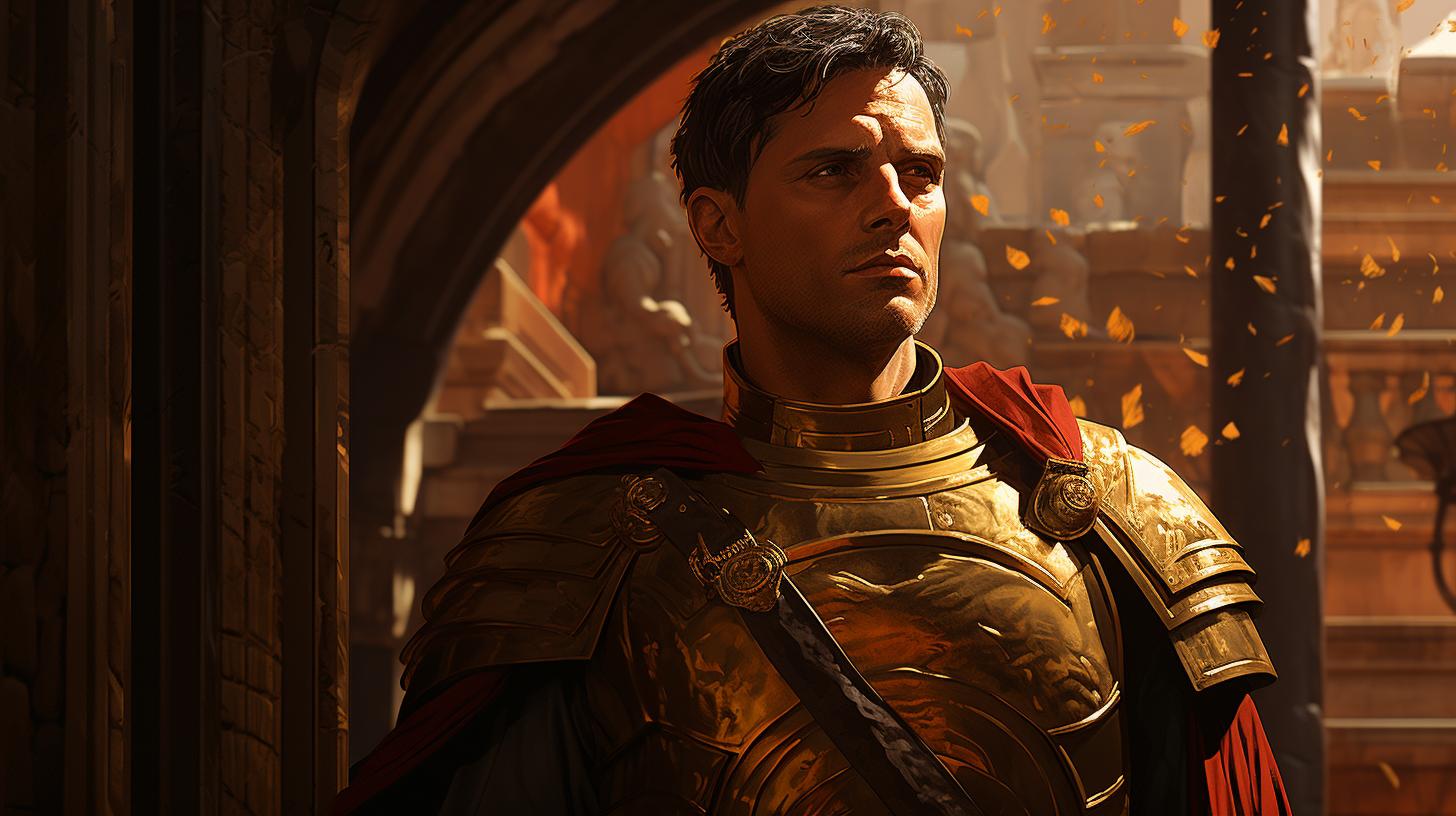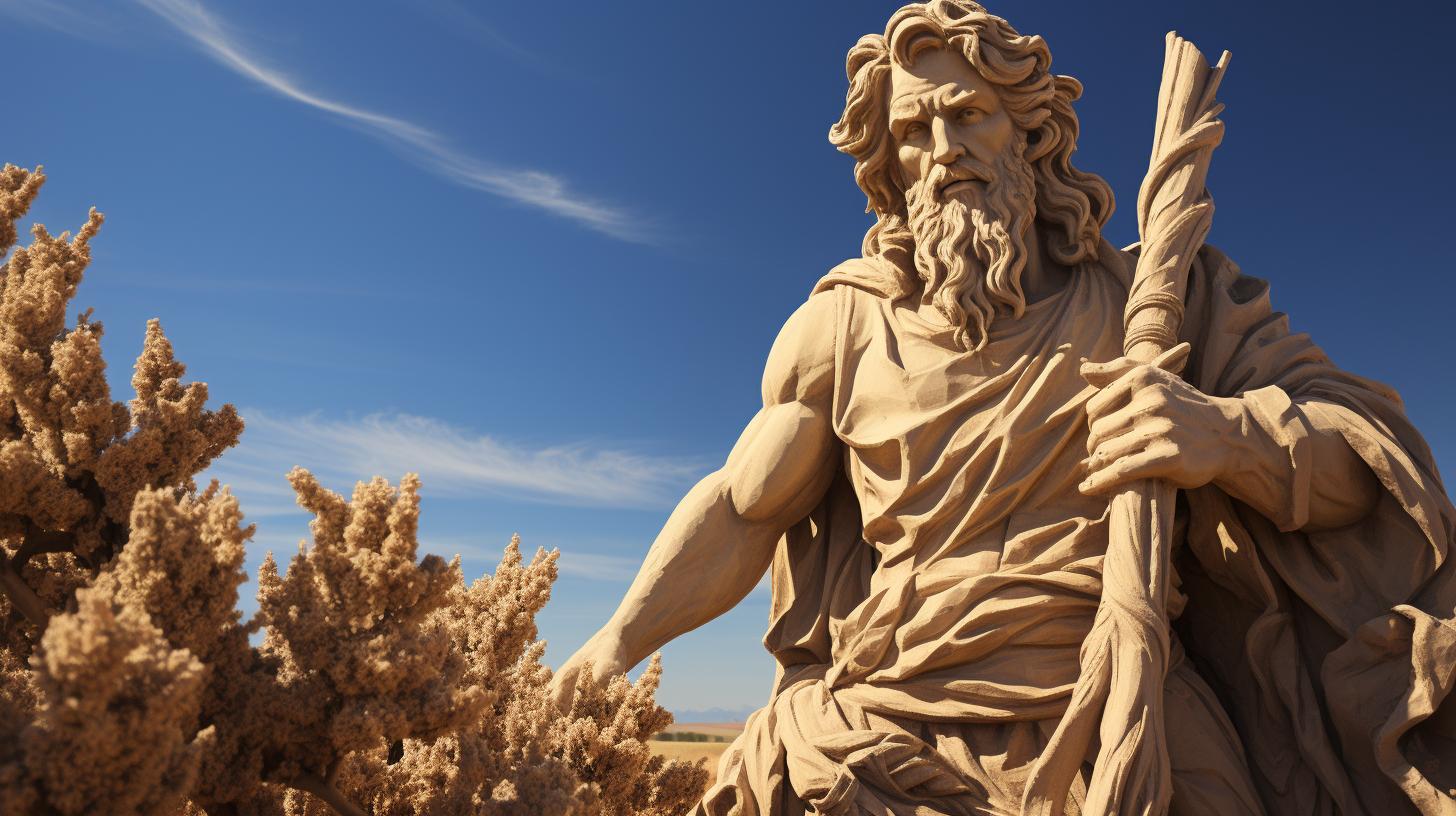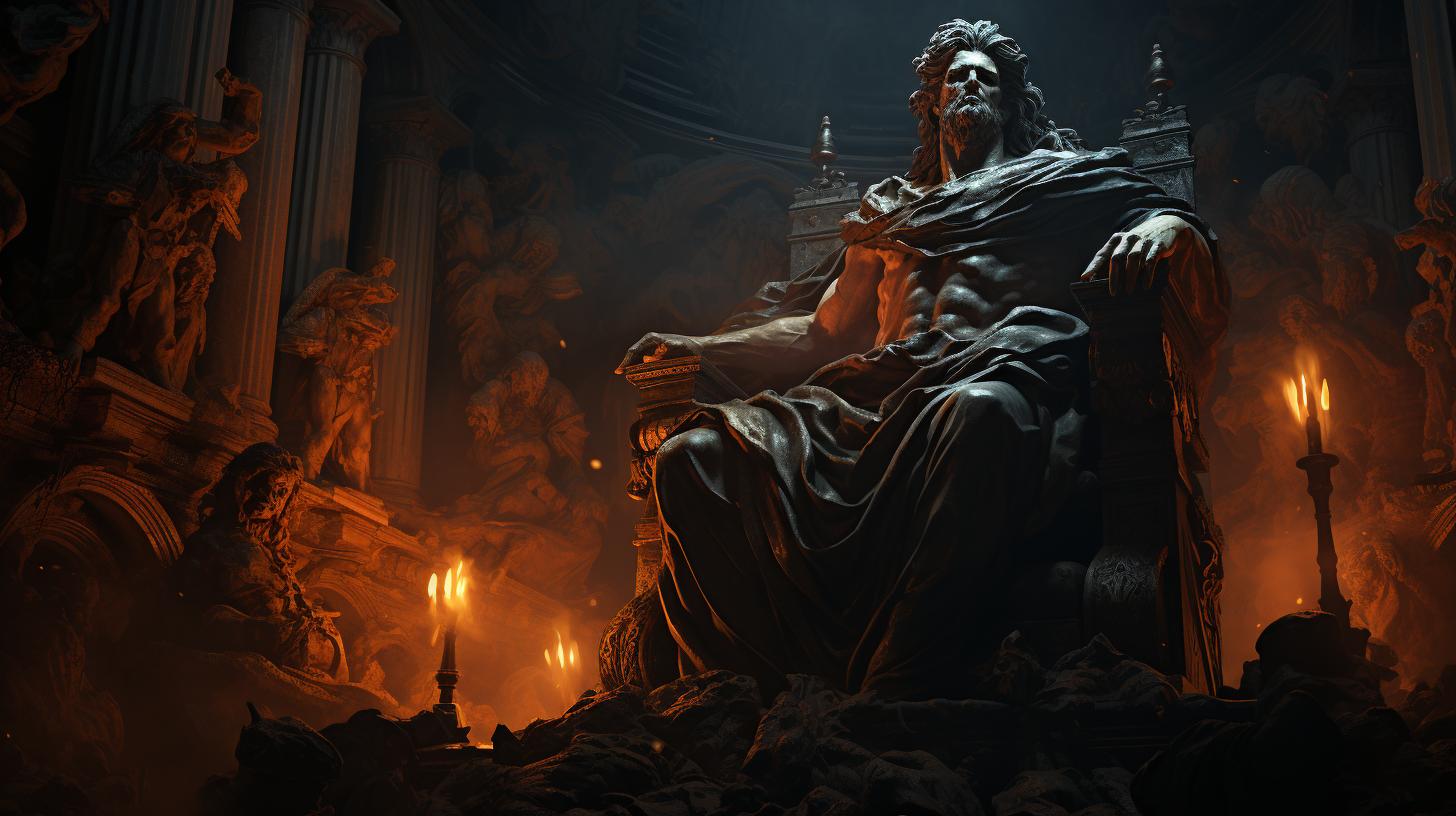The Mighty Sol: Exploring the Roman God of the Sun
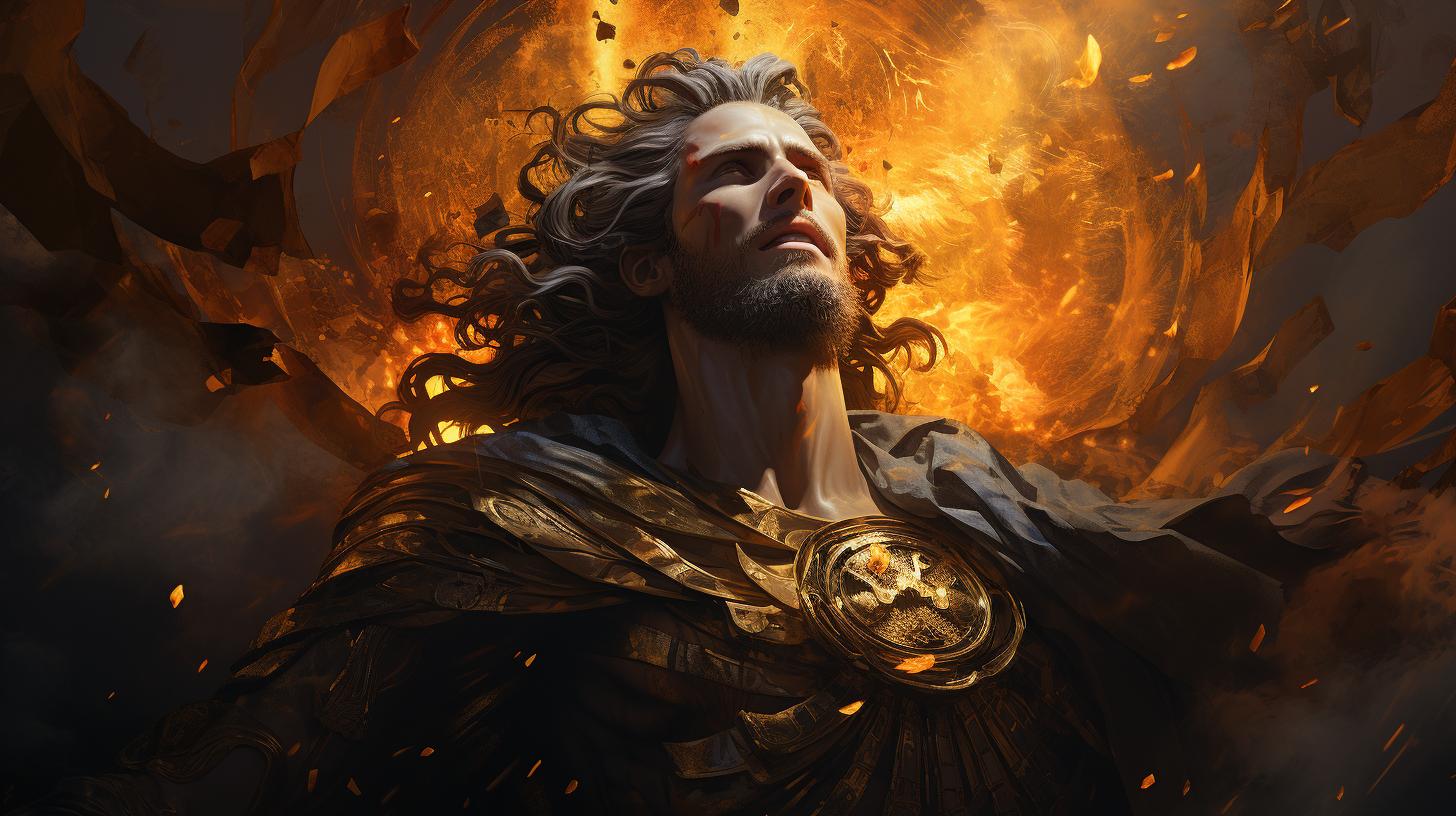
In ancient Rome, the worship of Sol, the personification of the Sun and an important deity, held great significance. Sol had two consecutive solar gods in Rome, Sol Indiges and Sol Invictus.
The origins of the word ‘sol’ for ‘Sol’ can be traced back to the Proto-Indo-European language. The cult of Sol was introduced in the Roman Republic by Titus Tatius. Sol’s significance continued during the 4th century, with influential figures like Vettius Agorius Praetextatus maintaining the worship.
Sol’s connection with Apollo and appearance in Mithraic representations further enhanced his importance. Combining oriental influences, Sol Invictus emerged in the late Roman Empire, continuing his cult until Emperor Constantine the Great declared Sunday as the official festive day of Sol Invictus, later reshaped as Christmas.
Continuing to fascinate today, Sol’s legacy in Roman solar worship remains intriguing.
The Origins of Sol: Exploring the Roman Sun God
The Ancient Roman Beliefs and Deities
In ancient Rome, the worship of Sol, the personification of the Sun, held great significance. The Romans had a complex religious belief system, and the sun played a central role in their cosmology.
They attributed divine characteristics to Sol, considering it an important deity deserving of reverence.
The Mythological Connections: Sol, Helios, and Mithras
Sol, known as Sol Invictus, was associated with the Greek god Helios and shared similar attributes. Both figures represented the sun’s power and radiance. Additionally, Sol had connections to the mystical god Mithras, popular among Roman soldiers.
These interconnections showcased the complex amalgamation of different religious beliefs within the Roman Empire.
The Role of Sol in Roman Society
Sol played a significant role in Roman society, symbolizing vitality, fertility, and divine protection. The Romans recognized the sun’s importance in sustaining life, agriculture, and the overall well-being of their civilization.
As such, Sol’s worship permeated various aspects of Roman life, influencing religious practices, festivals, and architectural dedications.
Sol in the Roman Empire: Rise and Significance
The Roman Empire witnessed the rise of Sol, the esteemed god of the sun, whose significance permeated every facet of Roman society. This section explores the various dimensions of Sol’s presence during this era, shedding light on the enduring worship of the unconquered sun.
Sol Invictus: The Unconquered Sun
At the heart of Sol’s prominence was his association with invincibility. Sol Invictus, meaning the “Unconquered Sun,” symbolized the eternal power and steadfastness of the sun. This divine aspect resonated deeply with the Roman populace, who sought resilience and victory in all spheres of life.
The Influence of Sol in the Late Roman Empire
During the later years of the Roman Empire, Sol’s influence grew even stronger as solar worship became increasingly intertwined with Roman cultural and religious practices. The concept of Sol, as a celestial force driving life and vitality, seeped into the consciousness of the Roman people, leaving a lasting impact on their beliefs and traditions.
Sol Invictus and the Cultural Integration of Solar Worship
Sol Invictus not only inspired individual devotion but also infiltrated the wider cultural fabric of the Roman Empire. As aspects of solar worship blended with local customs and beliefs, Sol became an integral part of various religious practices and rituals.
The syncretism of solar worship allowed for the coexistence and amalgamation of diverse traditions, enriching the spiritual landscape of the empire.
Exalting the enduring power of Sol, the Roman Empire experienced a profound impact from the worship of the sun god. The recognition of Sol as the Unconquered Sun, his influence in the late empire, and the cultural integration of solar worship all contributed to his rise and significance during this transformative period.
Sol’s Temples and Festivals in Ancient Rome
The temples dedicated to Sol played a significant role in ancient Roman society, emphasizing the importance of the Sun god in their religious beliefs. Let’s explore the Temple of Sol in the Circus Maximus, the Quirinal sanctuary, and the various festivals and celebrations honoring the Sun god.
The Temple of Sol in the Circus Maximus
Located in the heart of Rome, the Circus Maximus housed an ancient temple dedicated to Sol. This majestic temple stood as a prominent landmark, showcasing the devotion of the Romans to their Sun god.
Its magnificent architecture and intricate designs reflected the grandeur attributed to Sol.
The Quirinal Sanctuary and Other Places of Worship
Besides the Temple of Sol in the Circus Maximus, the Romans also established a sanctuary dedicated to Sol on the Quirinal Hill. This hilltop sanctuary provided a serene space for worshippers to connect with the divine presence of the Sun god.
Additionally, other places of worship dedicated to Sol existed throughout the city, offering various locations for the faithful to pay tribute to their beloved deity.
Festivals and Celebrations Honoring the Sun God
The worship of Sol was accompanied by numerous festivals and celebrations that celebrated the power and grandeur of the Sun. One such festival was the Dies Natalis Solis Invicti, held on December 25th, which marked the rebirth of the unconquerable Sun.
The Romans would gather to offer prayers, perform rituals, and partake in joyful festivities to honor Sol during these celebrations.
These temples and festivals served as important cultural and religious symbols, demonstrating the deep reverence the Romans had for Sol, the Roman Sun god.
Sol and the Roman Army: The Divine Protector
The worship of Sol as the patron deity of the Roman Army held great significance in ancient Rome. Soldiers revered Sol as their divine protector, believing that his radiance would guide them to victory on the battlefield.
Sol as the Patron Deity of the Roman Army
Sol held a special place in the hearts of Roman soldiers, who saw him as a powerful and unwavering force in their military campaigns. They believed that Sol’s presence would ensure their success and bring them glory in battle.
The Radiate Crown: Symbol of Solar Power
One prominent symbol associated with Sol and the Roman Army was the radiate crown. This distinctive crown represented the sun’s rays and was often depicted on coins, sculptures, and military standards.
The radiate crown served as a powerful reminder of Sol’s solar power and the divine protection he provided to the Roman soldiers. It symbolized their connection to the Sun God and their unwavering loyalty to the empire.
Sol’s Role in Military Ceremonies and Practices
Throughout the Roman Empire, various military ceremonies and practices honored Sol. Soldiers would offer prayers and sacrifices to seek his favor before going into battle, believing that Sol’s blessings would guarantee victory.
Moreover, military units would often hold processions and parades, carrying the symbols of Sol and displaying their devotion to the Sun God. These rituals served as a way to unite the soldiers and reinforce their commitment to the Empire, with Sol at the forefront of their revered pantheon.
In times of war, temples dedicated to Sol would become focal points for soldiers seeking solace and divine intervention. These sacred spaces provided a sanctuary where soldiers could find solace and reassurance, knowing that Sol watched over them.
The association of Sol with the Roman Army not only strengthened the soldiers’ morale but also instilled a sense of unity and purpose among their ranks. It exemplified the amalgamation of religious beliefs and military might that characterized Roman society.
Sol Invictus in the 4th Century: The Cult’s Expansion
In the 4th century, the cult of Sol Invictus experienced a significant expansion, solidifying its influence in the late Roman Empire. This period marked the rise of Emperor Aurelian, who played a crucial role in promoting Sol Invictus as a widespread religious practice.
Emperor Aurelian and the Rise of Sol Invictus
Emperor Aurelian, known for his military victories, recognized the political and religious potential of Sol Invictus. He officially embraced the cult of Sol Invictus and promoted it as a unifying force for the vast Roman Empire.
Aurelian aimed to leverage the popularity of the sun god to create a sense of unity among the diverse inhabitants of the empire.
Sol Invictus in the Late Roman Empire
The endorsement of Sol Invictus by Emperor Aurelian paved the way for its widespread adoption throughout the late Roman Empire. The cult’s popularity reached its peak during this period, as a growing number of people saw Sol Invictus as a symbol of power, victory, and prosperity.
The religious significance attached to the cult of Sol Invictus contributed to its influence in various aspects of Roman society.
Sol Invictus Leiden and Continued Solar Worship
Despite the decline of the Roman Empire in the following centuries, the worship of Sol Invictus continued to thrive. The cult’s teachings and practices persevered through various religious movements and cultural changes, leaving a lasting legacy.
Sol Invictus’s influence can still be observed in contemporary societies, reflecting the enduring impact of Roman solar worship.
Solar Gods in Roman Mythology: Beyond Sol
Exploring the fascinating world of Roman mythology, we delve into the realm of solar gods beyond Sol. These deities held immense significance in the ancient Roman belief system, and their connections and relationships with Sol shed light on the complexities of Roman sun worship.
The Connection between Sol and Apollo
One of the most prominent solar gods in Roman mythology is Apollo, who shares a deep connection with Sol. Both deities represent the power and brilliance of the sun, albeit from different cultural perspectives.
Apollo, of Greek origin, embodies the attributes of light, truth, and healing, while Sol, rooted in Roman tradition, symbolizes the vitality and life-giving aspects of the sun.
Mithras and Other Solar Deities in Roman Beliefs
Besides Sol and Apollo, Roman mythology encompasses several other solar deities that contribute to the multifaceted tapestry of solar worship. Mithras, a Persian god incorporated into Roman beliefs, became especially popular during the late Roman era.
Mithras, often depicted slaying a bull, personifies the sun’s invigorating energy and acts as a mediator between the heavens and the earth.
Sol’s Relationship with Castor, Pollux, Janus, and Jupiter
Within Roman mythology, Sol’s connections extend beyond Apollo and Mithras. He shares a special relationship with Castor and Pollux, twin brothers who guard mariners and represent celestial light. Janus, the two-faced god, represents transitions and beginnings, with one of his faces looking toward the rising sun.
Additionally, Jupiter, the king of the gods, is associated with the sun’s radiant power and authority.
As we explore the expansive realm of solar gods in Roman mythology, we uncover a rich tapestry of divine beings intricately linked to the sun’s radiance and vitality. Each deity brings a unique perspective and role, contributing to the complex web of beliefs and worship that shaped ancient Roman society.
Roman Solar Worship and its Influence
Roman Solar Worship played a significant role in the religious practices of ancient Rome, leaving a lasting impact on the civilization’s beliefs and cultural development. Through the worship of various solar cults, the Romans incorporated the power and symbolism of the sun into their religious rituals and traditions.
This section explores the influence of solar cults on Roman religion, the religious policies of Roman emperors regarding Sol Invictus, and the legacy of Sol’s worship with the transition to the Christmas celebration.
The Impact of Solar Cults on Roman Religion
The introduction of solar cults, particularly the worship of Sol, greatly influenced and shaped Roman religious practices. The Romans associated the sun with vitality, power, and divinity, attributing these qualities to Sol.
As the personification of the sun, Sol became a significant figure in the pantheon of Roman gods, with his worship entwined with various religious ceremonies and festivals.
- Sol’s association with light and life influenced Roman perspectives on spiritual enlightenment and the cycle of creation and rebirth.
- His worship as a celestial god offered a sense of hope and security, as the sun’s presence and warmth were crucial for sustaining life on Earth.
- The prominence of Sol in Roman religion also reflected the importance of solar symbolism in architecture, art, and daily rituals.
Sol Invictus and the Roman Emperor’s Religious Policies
One of the notable aspects of Roman Solar Worship was the rise of Sol Invictus as an official state religion during the late Roman Empire.
This section focuses on the religious policies of Roman emperors in relation to Sol Invictus and its integration into the Roman society.
- Emperor Aurelian played a significant role in promoting Sol Invictus as the official cult of the empire, elevating Sol to the rank of the primary deity and merging solar symbolism with imperial power.
- The emperors embraced Sol Invictus as a unifying force that transcended religious and cultural differences within the vast Roman Empire.
- By aligning themselves with Sol Invictus, the emperors aimed to consolidate their authority and foster a sense of loyalty and devotion among the Roman populace.
Sol’s Legacy: Transition to Christmas Celebration
The influence of Roman Solar Worship extended far beyond the decline of the Roman Empire.
Sol’s legacy can be traced to the transition from pagan traditions to the celebration of Christmas.
- With the rise of Christianity, the early Christian leaders strategically adopted December 25th, the day of Sol Invictus’ celebration, as the birthdate of Jesus Christ, effectively merging the symbolism of the sun god with the religious significance of Christ’s birth.
- The incorporation of Sol Invictus’ festivities into Christmas celebrations allowed the Christian religion to co-opt existing pagan customs and rituals, facilitating the spread and acceptance of Christianity throughout the Roman Empire and beyond.
- Today, many Christmas traditions and symbols, such as the prominence of light, the use of evergreen decorations, and the celebration of the winter solstice, can be traced back to the influence of Sol’s worship in ancient Rome.
The Aftermath: Legacy and Rediscovery
Sol Invictus Today: Traces of the Ancient Cult
Sol’s influence can still be seen in various aspects of modern culture.
From architectural designs inspired by Roman temples dedicated to Sol to artistic representations of the radiant crown, traces of the ancient cult are evident. Additionally, Sol Invictus celebrations have become a topic of interest for historians, archaeologists, and enthusiasts of ancient religions.
Revival of Interest in Sol and Roman Sun Worship
In recent years, there has been a notable resurgence in the study and appreciation of Sol and Roman sun worship. Scholars and researchers continue to delve deeper into the historical significance of Sol’s worship and its impact on Roman society.
This revival of interest has sparked new discussions and interpretations of Sol’s role in ancient Rome.
Debunking Myths and Misconceptions about Sol
Over time, various myths and misconceptions have arisen regarding Sol and his worship. This sub-section aims to dispel these misconceptions by providing accurate information based on historical evidence and scholarly research.
By debunking these myths, we can gain a clearer understanding of the true nature of Sol’s worship in ancient Rome.
- Myth: Sol was the sole sun god worshipped in ancient Rome.
- Reality: While Sol was highly revered, other solar deities like Helios and Mithras also played significant roles in Roman sun worship.
- Myth: Sol Invictus celebrations were solely religious in nature.
- Reality: Sol Invictus festivities often had cultural and social dimensions, involving games, processions, and communal gatherings.
- Myth: Sol Invictus was celebrated as a precursor to Christmas.
- Reality: While Sol Invictus celebrations took place around the same time as Christmas, the direct influence on the Christian holiday remains a subject of debate among scholars.
As we delve deeper into the legacy and rediscovery of Sol, we gain a deeper appreciation for the complexities of Roman solar worship.
The traces of this ancient cult continue to captivate and inspire, creating a dialogue between the past and the present…..

